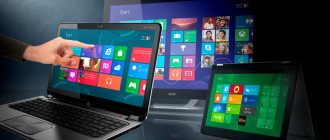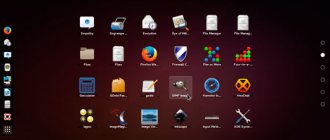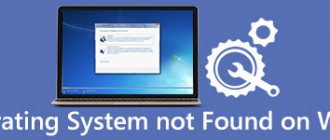The first version of the Android operating system was released in 2009. At that time it was very simple, which is typical for any software product. Over time, it began to acquire functionality, becoming a full-fledged operating system for mobile devices. Let's see what the latest version of Android is and how it differs from its predecessors.
At the time of writing, the latest version is the Android 10.0 Q operating system.
Android 1 "Apple Pie"
Already from the first version, the operating system began to receive names associated with sweets. Moreover, the first letters of the version names are sorted alphabetically, starting with the Latin A. Android 1.0 is a stable release in September 2008, which went to the masses. It’s unlikely that anyone remembers the appearance of this operating system, since the prevalence of the first devices was small. By the way, at the time of its release there was already an application store - then it was called the Android Market.
The main advantage of Android 1 “Apple Pie” was that it received all the basic functionality - it was modernized within one year. As a result, Android devices began to look more like pocket computers than just phones. The downside was that the first version was slow and lacked flash support.
Android 1.5 Cupcake
This intermediate version was widely adopted. It was installed on the first Android smartphones. Support for third-party keyboards appeared here, and playback of 3GP and MPEG-4 video files was launched. A definite plus was support for the A2DP profile, which made it possible to connect wireless stereo headsets. Their decoration was the animation of switching between windows. Another cool feature is uploading videos to YouTube.
Android 1.6 Donut
This version has improved the operation of the application store and increased operating speed. A universal search bar has also appeared here, a new interface for working with the camera has been implemented, and a multilingual search has been launched.
Android devices
In 2008, the first device was released that ran on Android. The device was developed by HTC. It was a smartphone called HTC Dream. After this, several more phone manufacturers expressed a desire to produce mobile devices that support this operating system.
Soon a tablet based on the Android platform was announced. In 2009, a photo frame running on this OS appeared on the market. In addition, after 2 years, the Blue Sky organization developed a new wristwatch, which was called i'm Watch. They also support this system.
Camera manufacturers also decided to keep up and introduced the first camera in the world that runs on Android. The new product was released by Nikon. In addition, game consoles, e-books and media players operate on this platform. It is expected that some more devices will appear soon.
At this rate of development, the Android platform will become the absolute leader among other operating systems, leaving all competitors behind.
Thanks to a well-designed interface, easy use and reliable data protection, devices running this OS are certainly worthy of attention.
Android 2.0 "Eclair"
The new version of Android with the tasty name “Eclair”, released in October 2009, received hardware acceleration, a search function for text and multimedia messages, support for live wallpapers, new maps and a calendar. There is flash support, quick access to contacts, tethering (distributing the Internet via Wi-Fi), automatic updating, voice dialing via Bluetooth, support for Adobe Flash 10.2, clipboard, support for sensors and sensors, support for multiple cameras.
At the same time, the developers updated the interface and introduced support for multiple cameras. In intermediate versions, additional functions were introduced to increase screen resolution, support multiple touches, and increase productivity. Work was also carried out to eliminate errors in various modules and applications. A fair number of users have seen smartphones and tablets running Android 2.0 and intermediate versions.
The most widely used intermediate versions are Android 2.2 and Android 2.3 – devices based on these versions were produced even in 2014.
The advantage of Android 2.0 and its intermediate versions is a noticeable speedup. It has also become possible to produce devices with higher screen resolutions (up to 720p). The disadvantage of the system was its not very convenient user interface. There was also no support for keyboards, mice and other input devices.
Android 2.2 Froyo
The version became faster, it expanded the Bluetooth functionality - it became possible to transfer contacts and carry out voice dialing (at that time even simple phones could do this). The same version introduced Internet distribution via Wi- Fi and a USB cable. Support for Adobe Flash 10.2 has also been implemented.
Android 2.3 Gingerbread
One of the most popular intermediate versions in the past. Its features:
- Updated interface;
- Support for the SIP protocol has appeared;
- NFC support has appeared;
- Launched the clipboard for copy and paste operations;
- Sensor support;
- Multiple camera support.
It also added sound effects and support for ultra-high resolution screens. Minor improvements and corrections were introduced in subsequent subversions.
It's all about apps
As you can easily see, using Android is fundamentally different from using “regular Linux” - you don’t need to open and close applications, you simply switch between them, as if all applications were always running. Indeed, one of the unique features of Android is that applications do not directly control the process in which they are running. Let's talk about this in more detail.
The basic unit in Unix-like systems is the process. Low-level system services, individual commands in the shell, and graphical applications are processes. In most cases, a process is a black box to the rest of the system—other system components don't know or care about its state. The process begins executing by calling the main() function (actually _start), and then implements some of its own logic, interacting with the rest of the system through system calls and simple interprocess communication (IPC).
Since Android is also Unix-like, all this is true for it, but while the lower-level parts - at the Unix level - operate on the concept of a process, at the higher level - the Android Framework level - the basic unit is the application. An application is not a black box: it consists of individual components that are well known to the rest of the system.
Android applications do not have a main() function, nor do they have a single entry point. In general, Android abstracts as much as possible the concept of an application being launched from both the user and the developer. Of course, the application process needs to be started and stopped, but Android does this automatically (I'll talk more about this in future articles). The developer is asked to implement several separate components, each of which has its own life cycle.
In Android, however, we explicitly decided we were not going to have a main() function, because we needed to give the platform more control over how an app runs. In particular, we wanted to build a system where the user never needed to think about starting and stopping apps, but rather the system took care of this for them… so the system had to have some more information about what is going on inside of each app, and be able to launch apps in various well-defined ways whenever it is needed even if it currently isn't running.
To implement such a system, applications need to be able to communicate with each other and with system services - in other words, a very advanced and fast IPC mechanism is needed.
This mechanism is Binder.
Android 3.0 "Honeycomb"
This version of Android was released in February 2011, but was rarely seen on mobile devices because the next version was released in the same year. Android 3.0 received improved performance and the ability to resize widgets. There was also support for multi-core processors, which were becoming more and more common. An additional advantage is support for full hardware acceleration, as well as the long-awaited support for external mice, keyboards and other input devices.
The advantages of Android 3.0 are improved support for tablet PCs and increased operating speed. The developers also made many minor fixes that improved system stability. Disadvantages - poor multitasking, lack of protection of user data, uninformative notification panel, slow operation on devices with a small amount of RAM, lack of multi-user mode, poor camera functionality.
Why is it good
This OS has a number of advantages. The main ones are:
- ease of use – the system is equipped with a QWERTY keyboard, which is comfortable and familiar to use, and you can choose any other among free and paid applications;
- the speed of the device - the gadget instantly responds to commands and completes the assigned tasks without freezing or other troubles;
- a huge range of applications and games - most of them are free, in addition, access to all Google products is open;
- there is no prohibition on installing various applications and add-ons;
- there is no need to install additional programs to access the device’s memory - to do this you need to connect to your computer using USB.
Android 4.0 "Ice Cream Sandwich"
Version Android 4.0 appeared in September 2011. Its intermediate versions were released until June 2014. During all this time, the operating system has received a huge number of changes. Appeared here:
- Improved spell checking;
- Traffic control;
- Data encryption;
- High-performance and functional camera;
- Autonomous voice input;
- Smooth interface animation “without jumps”;
- Google Now service;
- Well-thought-out notification panel;
- Supports multiple user profiles;
- Miracast technology;
- Supports connecting input devices via Bluetooth;
- Voice assistant “OK Google”;
- Large set of emoticons;
- Advanced synchronization with cloud services;
- Pedometer support;
- Android remote control.
There are so many changes and additions in Android 4.0 and in intermediate versions that they can be stretched over several pages. We have identified only the most important points. Thanks to them, Android devices have become full-fledged assistants of a modern person.
The advantages of Android 4.0 and later versions are enhanced work with external devices, rich functionality, improved user experience, high performance, reduced power consumption and much more. Disadvantages - slow operation on devices with a small amount of RAM, not very high stability.
Despite some shortcomings, devices running Android 4.x have become widespread - this operating system has received almost all the functionality necessary for smart smartphones and tablets.
Android 4.1, 4.2 and 4.3 Jelly Bean
Key changes:
- New features in the Camera app;
- Supports multiple user accounts;
- Widgets on the lock screen;
- 360 degree panoramas for publication on Google;
- Increased productivity;
- Voice input without Internet;
- Support for Braille input devices (for the blind);
- New gallery.
The number of changes is huge.
Android 4.4 Kitkat
Devices based on this operating system were produced for several years - it turned out to be popular and productive. A voice assistant, support for cloud storage, remote control, Chromecast, support for an infrared port, a sandbox, support for pedometers, an updated mail application, and support for cloud printers appeared here.
What it is
Android is the operating system that powers smartphones, tablets, and many other devices. Thanks to this OS, even the most inexpensive phone will be able to gain new capabilities. The system will allow you to install various useful programs on your device that will help you make full use of all the functions of the device.
All necessary software can be downloaded from the Play Market. This site contains more than 700 thousand programs. A wide range will allow you to find any application you need. Using the operating system, you can easily access the Internet, watch video files, communicate on social networks, listen to music, take photos and immediately post them to your account or read e-books.
It is worth noting that the OS is completely free. Moreover, it is very easy to use. It won't take much time to understand the interface. Thanks to all its advantages, it has become the most widespread in the world. In 2014, more than 86% of devices operating on this platform were sold.
Android 5.0 "Lollipop"
Previous versions of Android were not particularly energy efficient. The problem was resolved in Android 5.0 "Lollipop". This operating system works well on devices with little memory and saves battery power. The developers also managed to increase the stability of the system and make it more convenient. In version 5.1, basic support for two SIM cards appears - in devices on previous versions of the OS it was implemented by manufacturers.
The advantages of the system are a significant increase in stability, built-in VPN service, HD Voice support. Disadvantages: lack of control over applications and the data they use.
OS application
Since the advent of the Android operating system to the present day, developers have not been sitting idly by. The platform is constantly being improved. At the same time, its functionality is expanded by introducing new features.
The platform has become so popular and comfortable to use that many companies that develop modern gadgets have decided to release their devices based on this OS.
Using Android is not as difficult as it seems. With its help, you can perform almost the same actions on your device as on your computer.
The system provides several standard applications. Among them are:
- browser;
- Email;
- calendar;
- voice search;
- social network;
- navigator;
- weather;
- news.
All applications from Google.
Another nice plus is the ability to customize your desktop yourself. You can add an additional screen to your device where you can place shortcuts or widgets. You can also install any theme or wallpaper you like, thereby modifying the interface.
Android 7.0 and 7.1 "Nougat"
The operating system was released in 2016. It can work in multi-window mode, there is a call filtering function on board, grouping of notifications from one application has been implemented, full support for virtual reality has been made, new emoji icons have been added, data encryption has been improved, and the operation of applications in the background has been improved. Based on this OS, versions 7.1, 7.1.1 and 7.1.2 were released - round application icons appeared here, picture-in-picture support for some applications.
Competitors
The main competitors with which the Android platform has to fight for the palm are:
- Apple iPhoneOS;
- Microsoft Windows Mobile;
- RIM BlackBerry OS;
- Maemo/MeeGo;
- Samsung Bada OS;
- Palm webOS;
- Symbian OS.
Today, Android has become the most widespread mobile platform in the world than iOS. However, a presentation of the new Ubuntu Phone OS is planned soon. Perhaps it will become another serious competitor to Android.
Android 9.0 Pie
New in this version:
- New volume control;
- Adaptive Battery function to reduce power consumption;
- Automatic brightness change according to user preferences;
- New page “About phone”;
- Automatically turn on Bluetooth when driving;
- Advanced gestures;
- Control of time spent on a smartphone;
- A new type of notifications from instant messengers and chats with support for displaying all correspondence;
- Shifts the clock to the left of the notification panel.
Many other innovations have also appeared. The release date for the version is August 6, 2022.
Android version 6.0 with support for Google Now on Tap
Android 6 somewhat disappointed fans of this OS, since there were no significant changes in the interface and functionality. The developers focused on creating technology for searching the Internet for information about any element that is on the display. It's called Google Now on Tap. However, it did not gain the expected popularity.
In addition, Google has seriously taken to solving the problems with the vulnerability of its OS, starting regular release of patches and updates. It is also worth noting the emerging privilege management system, which requests permission to use certain functions of the device. To increase the operating time of devices, the Doze and App Standby functions were added.
Android 10.0 Q
This is a beta version only available on select devices. In the future, it will appear on flagships and expensive smartphones running Android 9.0 Pie. The release took place on March 13, 2022. Another dark theme has appeared here, support for additional resolutions, additional modes for application developers and a desktop operating mode.
The next version has already announced the main innovation - support for long screenshots, which can be useful in browsers. Estimated version name of Android 11 R.
3.7/5 — (3 votes)
Smartphone for geeks
Future Android creator Andy Rubin grew up in Chappaqua, New York. At some point, his father retrained from a psychologist to an electronics salesman, and Andy's room was filled with the latest gadgets. While still in school, he was crazy about computers, and after college he went to work at Carl Zeiss, where he developed robotic equipment. Then Rubin moved to Switzerland and could have stayed there for the rest of his life if not for a vacation in the Cayman Islands in 1989. One early sunny morning he was walking along the beach and saw a man sleeping in a sun lounger. It turned out to be Apple developer Bill Caswell (the girl kicked him out of the bungalow after a quarrel). Rubin talked to him and offered to live in his cottage. Soon Caswell invited him to return to the USA and join Apple (at that time it had just released its famous Macintosh). At the corporation, Rubin was developing the Quadra computer model.
In 1990, Apple spun off its computing device development into a separate company called General Magic, which Rubin joined two years later. Together with other developers, he built a kind of attic with beds above the working open space and began to spend all his time in the office, developing the operating system for Magic Cap mobile phones. But the idea was ahead of its time: telecommunications companies were not ready to accept it, and the company closed.
Then, together with other Apple veterans, Rubin developed WebTV - a kind of prototype of future Smart TVs. In 1997, their company was bought by Microsoft. One day, during a meeting with programmer friends that lasted until late at night, they decided to make a small candy bar that would cost ten dollars and allow one to scan any object and immediately find information about it on the Internet. “It’s like a digital sponge for attracting people to websites,” Rubin explained. The friends founded a company in Palo Alto called Danger, named after the robot from the old TV show Lost in Space who kept repeating that word. They added a radio receiver and transmitter to the new device, and then began telling investors about their smartphone with Internet access called Sidekick. Aspiring venture capitalist Greg Galanos believed in the idea and invested money in the project.
In early 2002, Rubin talked about the development of his Sidekick to Stanford students. Google founders Larry Page and Sergey Brin were present at this lecture for some reason. Afterwards, Page examined the device, saw that Google search was preinstalled there by default, and said: “Cool.”
How to set and change the ringtone
Not everyone likes the standard ringtone on a smartphone. Many users, after purchasing a mobile device, think that it would be a good idea to change the ringtone. In fact, this is not difficult to do; the procedure will take a little more than a minute.
- Go to the smartphone settings;
- Select the Sound section;
- Find the Ringtone item;
- A menu opens with ringtone options. If you scroll down the list, you can see the Add ringtone line, here you can add your own melody;
- To change other sounds on your smartphone, you should go to the advanced settings.
Your own ringtone will allow you to accurately determine when they are calling you and when they are calling one of your colleagues or friends. Many users set very original ringtones, so it is very difficult to confuse them.
init.rc Commands
The init process has a built-in set of commands, many of which follow the standard Linux command set. The most notable of them:
- exec /path/to/command - run an external command;
- ifup interface - raise the network interface;
- class_start class_name - start services related to the specified class;
- class_stop class_name - stop services;
- insmod /path/to/module - load kernel module;
- mount FS device directory - mount the file system;
- setprop name value - set a system variable;
- start service_name - start the specified service;
- trigger name - enable the trigger (execute the specified block of commands);
- write /path/to/file line - write a line to a file.
How to use the keyboard
Keyboards on different smartphones are slightly different. In addition, in the Play Market you can always find several keyboard options from third-party developers. But despite this, the techniques for entering and editing text are in most cases identical.
To call up the keyboard, just press your finger on the text input field and it will appear. To remove it, press the back button. Text is entered using the same principle as on a computer. To change the layout, click on the icon with a drawn globe. In the keyboard settings, you can select all the languages that may be needed for entering text.
To enter a capital letter, press the Shift key. If you hold it down, you can type several capital letters in a row. If you double-tap this key, all letters you type will be in capitals.
To delete incorrectly entered text, click on the button with an arrow pointing to the left. With one press, only one character is deleted; with a long press, the text is deleted in words. The longer the key is held, the faster the text is erased.
If the cursor needs to be moved to another place, you touch it with your finger. In some cases, there are arrows on the screen that allow you to quickly move the cursor.
Some keys have a main symbol and an additional one. To select an additional one, you need to hold down the key for a couple of seconds. In the same way, you can enter the letters Ъ and Ё, which are not on the keyboard. Hold down b and e long enough to select other letters.
In addition to the main screen, each keyboard has several additional ones. Service symbols, numbers and emoticons are hidden here. The screen switch key is located in the lower left corner of the keyboard.
In the Google Keyboard, you can quickly bring up the emoji screen by long pressing the Enter button.











